NEWER CALABRIA MUSEUMS
No matter where you dig in Italy, you’re bound to hit upon something ancient, or at the very least medieval. Calabria is certainly no exception. Exciting discoveries pop up with a certain frequency and new museums are even inaugurated from time to time, such as the Monasterace Museum that opened its doors in the town of the same name in April of 2015.
The jewel in the museum’s crown is the incredible drago marino (sea dragon) mosaic that I had first come across in Reggio’s archeological museum before it closed for renovation. Since that time a few new museums have opened up in smaller towns, featuring some of the artifacts formerly displayed in Reggio. The Monasterace Museum along Calabria’s Ionian Coast is one such museum. Located on what’s called the Costa dei Gelsomini or the Jasmine Coast in southern Calabria, the institution grew up in the area of an archeological park originally excavated by the famous Italian archeologist Paolo Orsi, who began work in the zone of ancient Caulonia in 1911.
CAULONIA
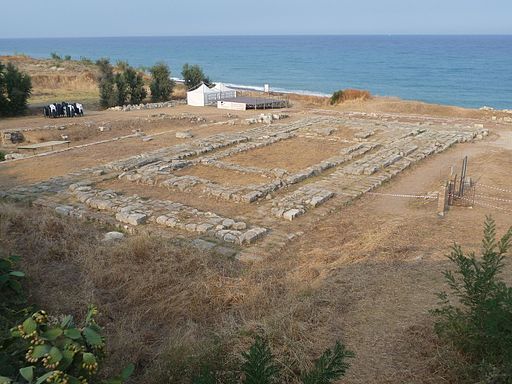
Ancient Temple in Caulonia/Kaulon, courtesy of Marcuscalabresus, Creative Commons
Caulonia or Kaulon was once a flourishing city of Greater Greece. Testament to its importance lies in the fact that it was one of the first cities of Magna Graecia to mint coins in silver. The area, known as the Stilaro for the name of its main river, was rich in natural resources, consisting of mineral deposits, timber and stone. To give some perspective with more modern times, the nearby town of Pazzano was the principal center for iron extraction in the Kingdom of the Two Sicilies and its steel works prospered into the 20th century.
Back in ancient times, the seaside city of Caulonia was founded in the 8th century BC. One colorful story dating from the 6th century BC tells of the defeat of Caulonia and its ally Kroton (today, Crotone) in the famous Battle of the Sagra, the river on Caulonia’s southern border. The opposition forces, Locri and its ally Reghion, were led to victory through the miraculous intervention of the Dioscuri, mythological twin brothers who came out of the sea on horses at a decisive moment in the battle. (A pair of marble statues representing the twin heroes, Castor and Pollux, are on display in Reggio’s archeological museum. They come from a temple in ancient Locri.)
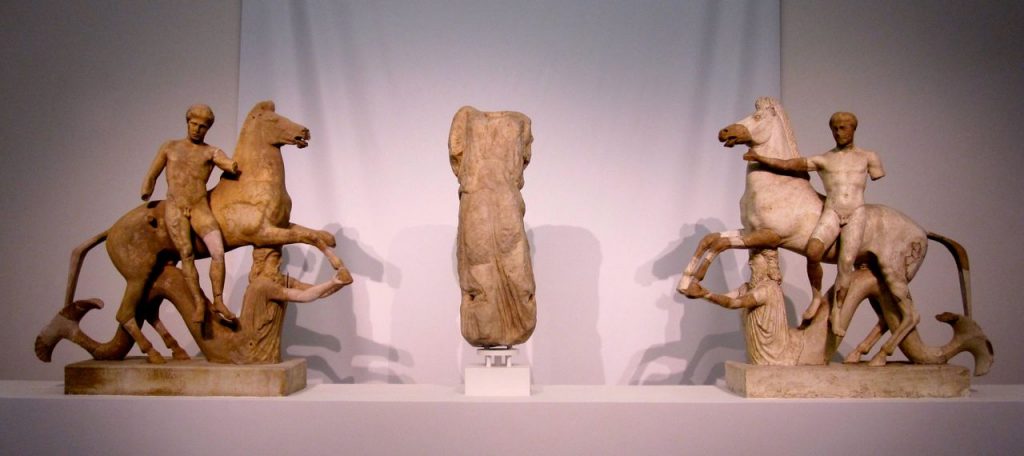
Dioscuri from Locri Epizephyrii, Reggio Archeological Museum
MONASTERACE MUSEUM
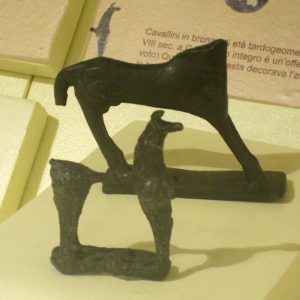
Ancient Bronze Horses
The Monasterace Museum has quite a nice collection of artifacts, ranging from smaller objects in bronze to terracotta vessels to larger architectural pieces. Two small horses in bronze exhibited together in one of the cases caught my eye. Dating from the second half of the 8th century BC, very early in the area’s Greek period, the figures struck me as almost modern with their simple, geometric lines. According to the descriptive tag, the one with the missing head would have decorated the handle of a cauldron, while the horse completely intact would have been an offering to a divinity.
I never tire seeing personal objects of the ancients, and I found two bronze mirrors from a necropolis particularly attractive. The fact that 2,500 years ago there were real people who held these functional, yet very beautiful articles in their hands, gazing at themselves in intimate moments, perhaps having similar thoughts to ours today, is amazing to me. The artisans’ meticulous attention to detail is masterful – the designs of the handle with the young man standing on the back of a turtle, the flower emblem on the one and the rooster perched on top of the mirror with the missing handle. These lovely mirrors were clearly created by and for sophisticated people.
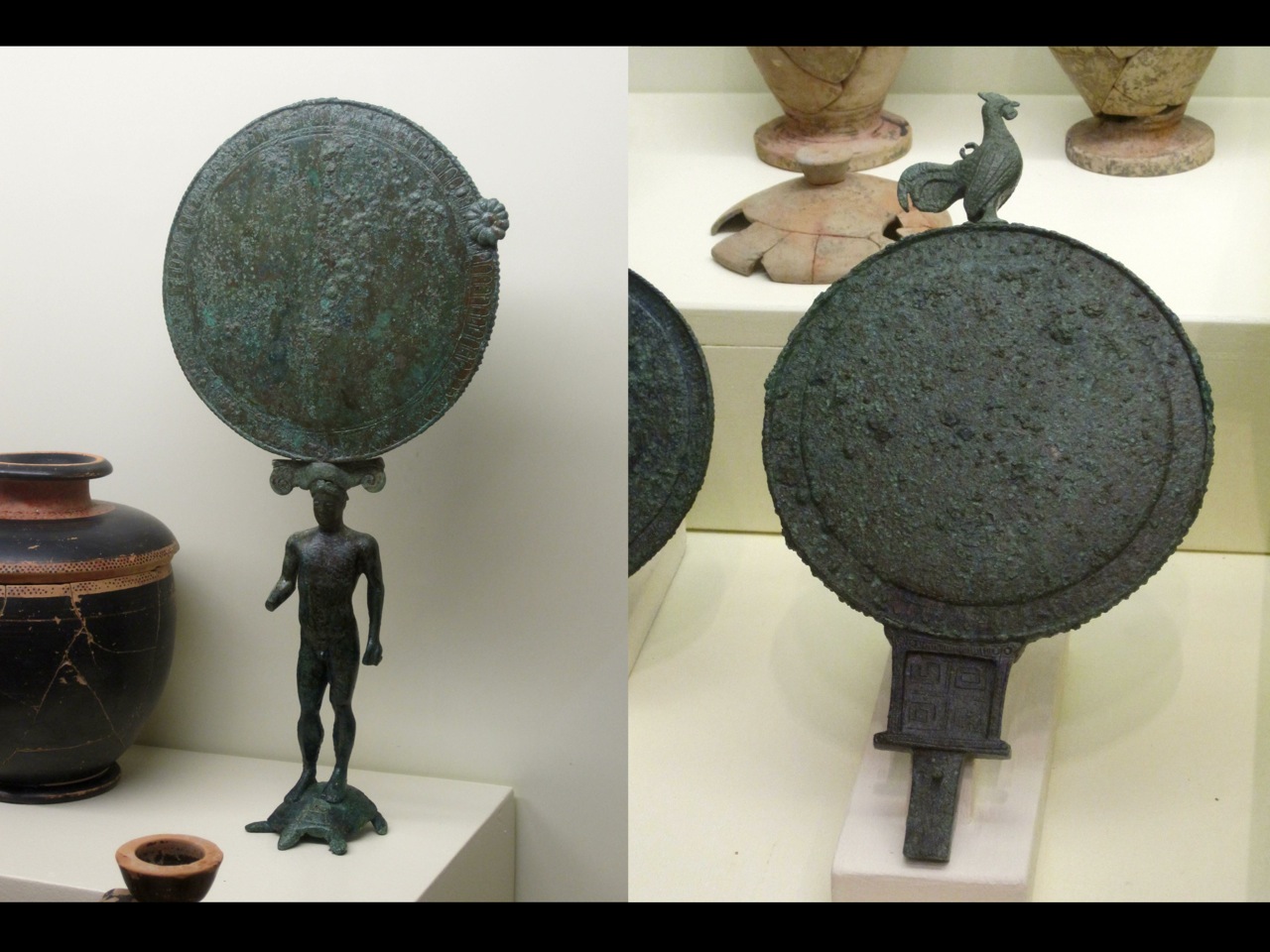
Bronze Mirrors with Figure on Turtle and Rooster, 5th-cent. BC
Such cultivated ancients would have walked across colorful mosaic floors in Caulonia’s most luxurious homes. The dragon mosaic pictured above adorned the entrance to the banquet hall of the opulent dwelling that archeologists have named La Casa del Drago (The House of the Dragon). The sea creature was not merely fanciful decoration, however. It was poised in attack mode to ward off evil spirits and bad luck. This dragon mosaic from the second half of the 3rd-century BC was meant to protect the banqueters feasting in the adjoining hall, which was decorated with a mosaic of white and black tiles depicting the waves of the sea.
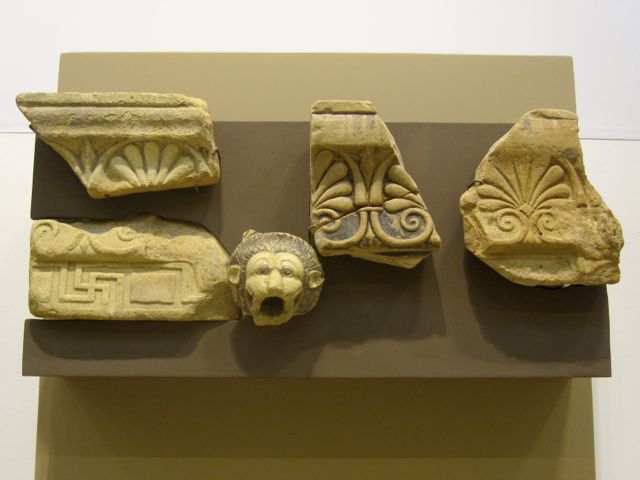
Architectural Elements in Monasterace Museum
The museum’s display also includes an assortment of architectural features. The multi-colored cornice with drain spouts in the form of lions’ heads is most impressive. Dating from the 5th-century BC, the ornamental element came from one of several temples in the sacred area outside the city on what was called the Passoliera hill. The lion’s head must have been a popular theme in Greek times as there was another one from roughly the same time period on exhibit with other architectural pieces from the area of Punta Stilo along the coast.
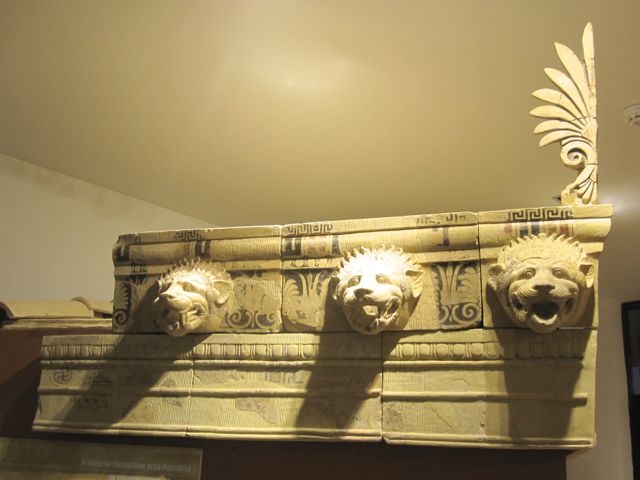
5th-cent. drain spouts from Kaulon
EXCITING DISCOVERIES FROM ANCIENT CAULONIA
The excavations of over 100 years ago revealed Caulonia’s urban center with the remains of a Doric temple, the stone wall surrounding the city, as well as the Passoliera sanctuary outside its limits. In 1969 the major discovery of the dragon mosaic was very exciting. Thus, digs continued, and in 2012 archaeologist Francesco Cuteri and his team uncovered the largest mosaic from the Hellenistic period in all of Southern Italy! This artwork, dating from the end of the 4th-century and beginning of the 3rd-century BC, covered the floor of a thermal bath and turned out to be even larger than previously thought with the discovery of another section the following year. Consequently, the mosaic extends to the dimension of 30 square meters (323 square feet). The images include a dragon, similar to the other drago marino but with striking blue tiles, several dolphins, a snake, plants and flowers.
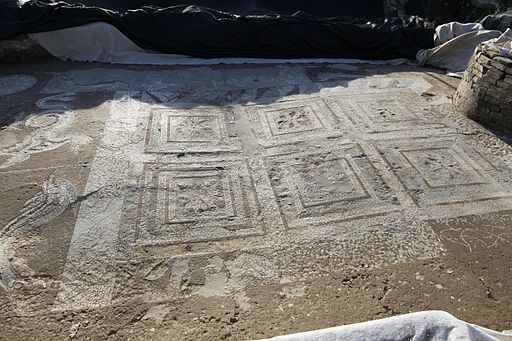
Thermal Bath Mosaics in Caulonia from Hellenistic Period, courtesy of Marcuscalabresus, Creative Commons
Visitors can wander through Caulonia’s archeological park. However, during most of the year the mosaics are covered up to protect them from the elements. Work is carried out in the summer months with volunteers under Cuteri’s supervision. Recently, there has been talk of transferring the mosaics somewhere indoors for their safekeeping as there have been serious problems with coastal erosion. Cuteri, who has worked on the Caulonia excavation for many, many years, is against taking them out of their context, also because it would seem that, finally, both the funds have been secured and the bureaucracy is getting itself together to put a plan in place to protect the coastline and this precious archeological site sometime within the near future.
Incredibly, the monumental mosaic hasn’t been the only important discovery in recent years. In 2013 a bronze tablet from the 5th-century BC was found in Caulonia’s urban sanctuary. The tablet’s significance lies in its inscription written in the Achaean alphabet. At 18 lines, it is the longest passage found in all of Greater Greece recorded in this archaic language that originated in Achaea, an ancient region on the north coast of the Peloponnesus peninsula.
How many more mysteries lie buried in Caulonia’s distant soil, already abandoned by the time of Christ? By then, the sea had long begun its encroachment of the city, and many artifacts have been found in the water off the coast. What will be uncovered next?
I predict the Monasterace Museum and Archeological Park will be worth another visit in the very near future.
Interested in experiencing Southern Italy on a small-group cultural tour? Check out the itineraries of my Calabria Tours and my Basilicata Tour and get in touch!
Looking for an authentic restaurant experience near the Monasterace Museum? Wind your way up the hill to Martone. Here’s a preview: Calabrian Eateries: Trattoria La Collinetta in Martone.
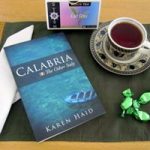 Read more about the beautiful land in the toe of the Italian boot in Calabria: The Other Italy, my non-fiction book about daily life, history, culture, art, food and society in this fascinating southern Italian region. Widely available in paperback and e-book versions.
Read more about the beautiful land in the toe of the Italian boot in Calabria: The Other Italy, my non-fiction book about daily life, history, culture, art, food and society in this fascinating southern Italian region. Widely available in paperback and e-book versions.
“Like” Calabria: The Other Italy’s Facebook page and follow me on Karen’s Instagram and Karen’s Twitter for more beautiful pictures and information.
Sign up below to receive the next blog post for free directly to your email.

Comments 2
The beauty & intricacies of all this ancient work, NEVER ceases to amaze me ….. and YOU have seen so much of it at the original locations!
Author
Absolutely – incredible style and refinement! And seeing such works on location enhances the perspective.